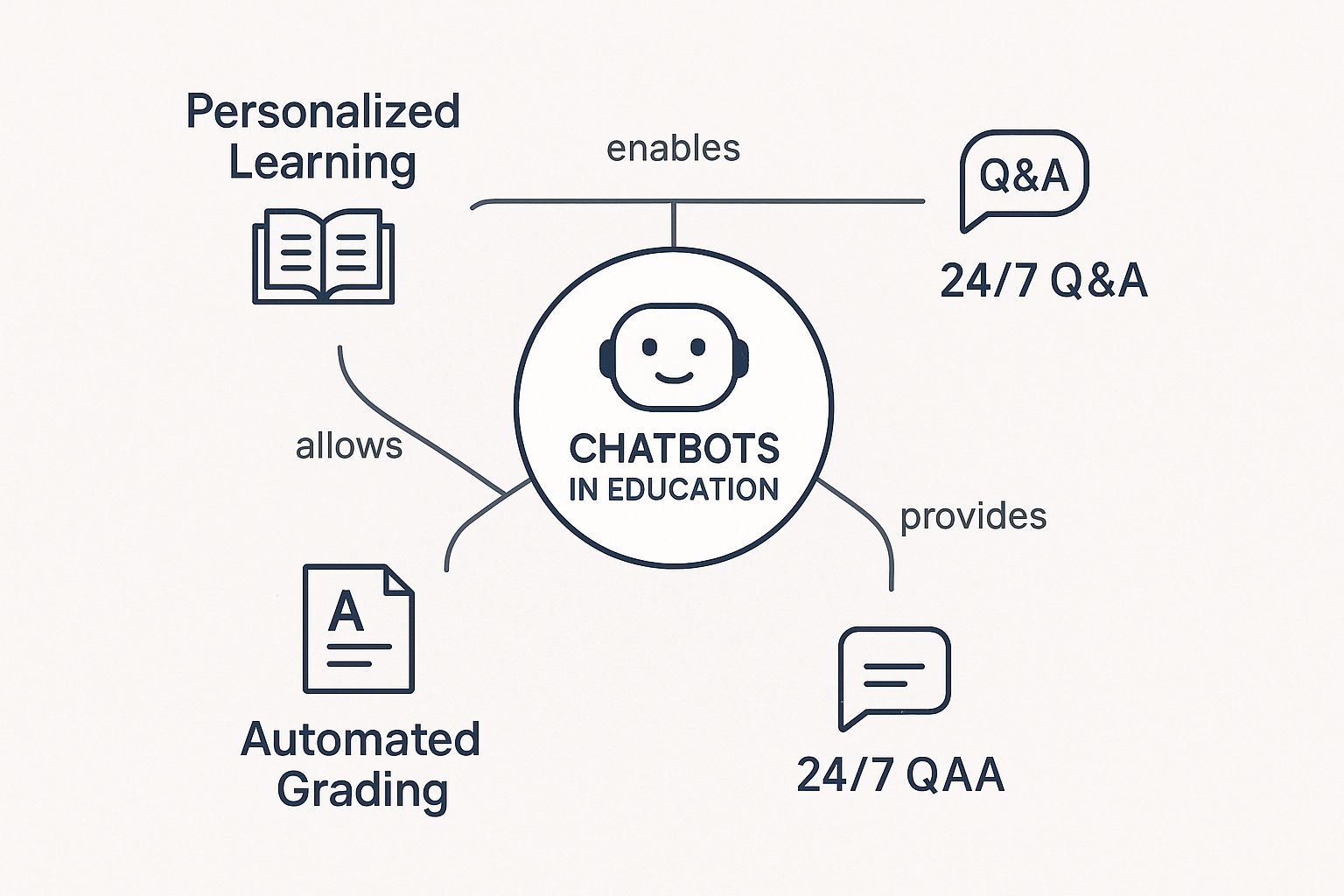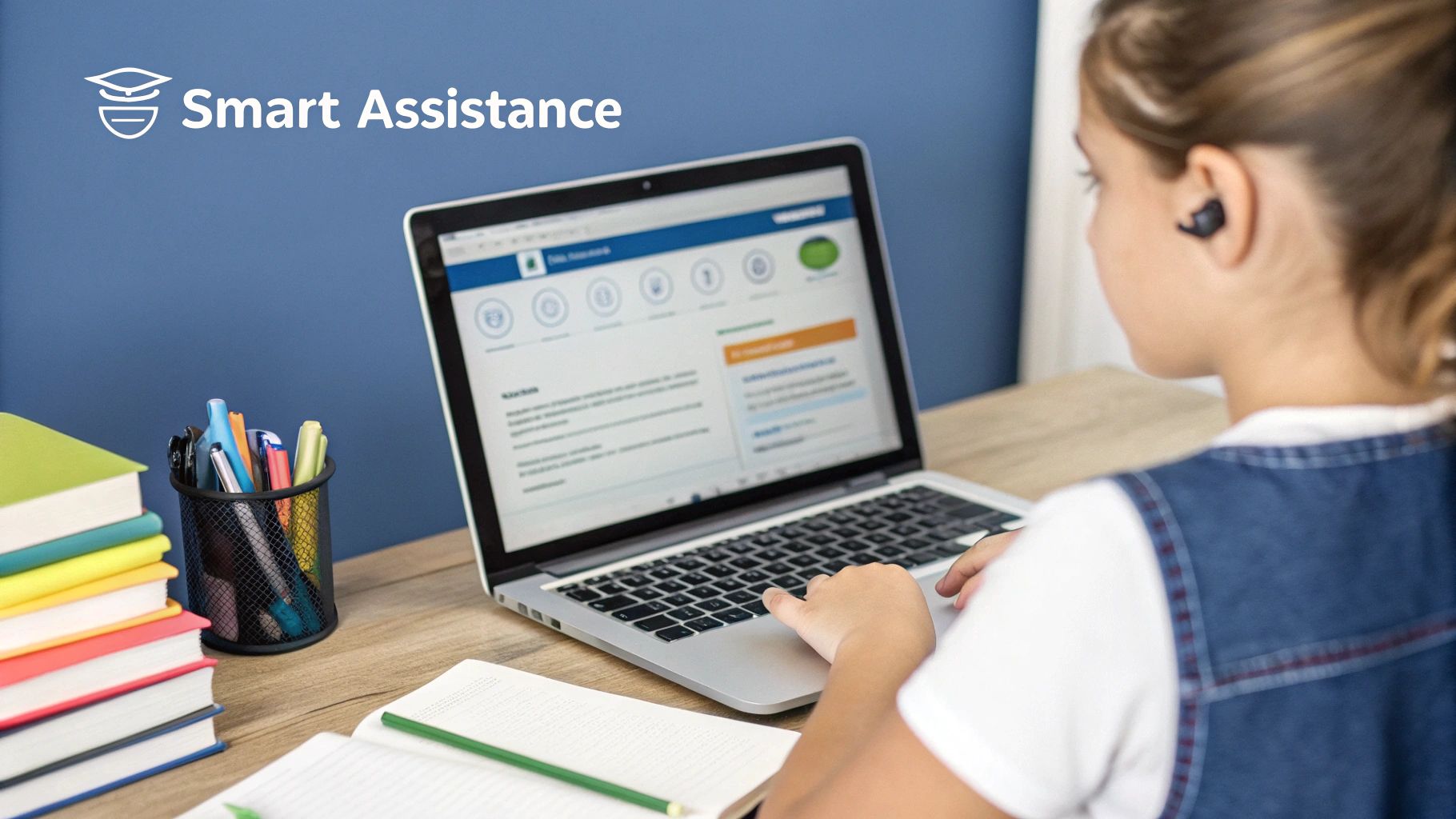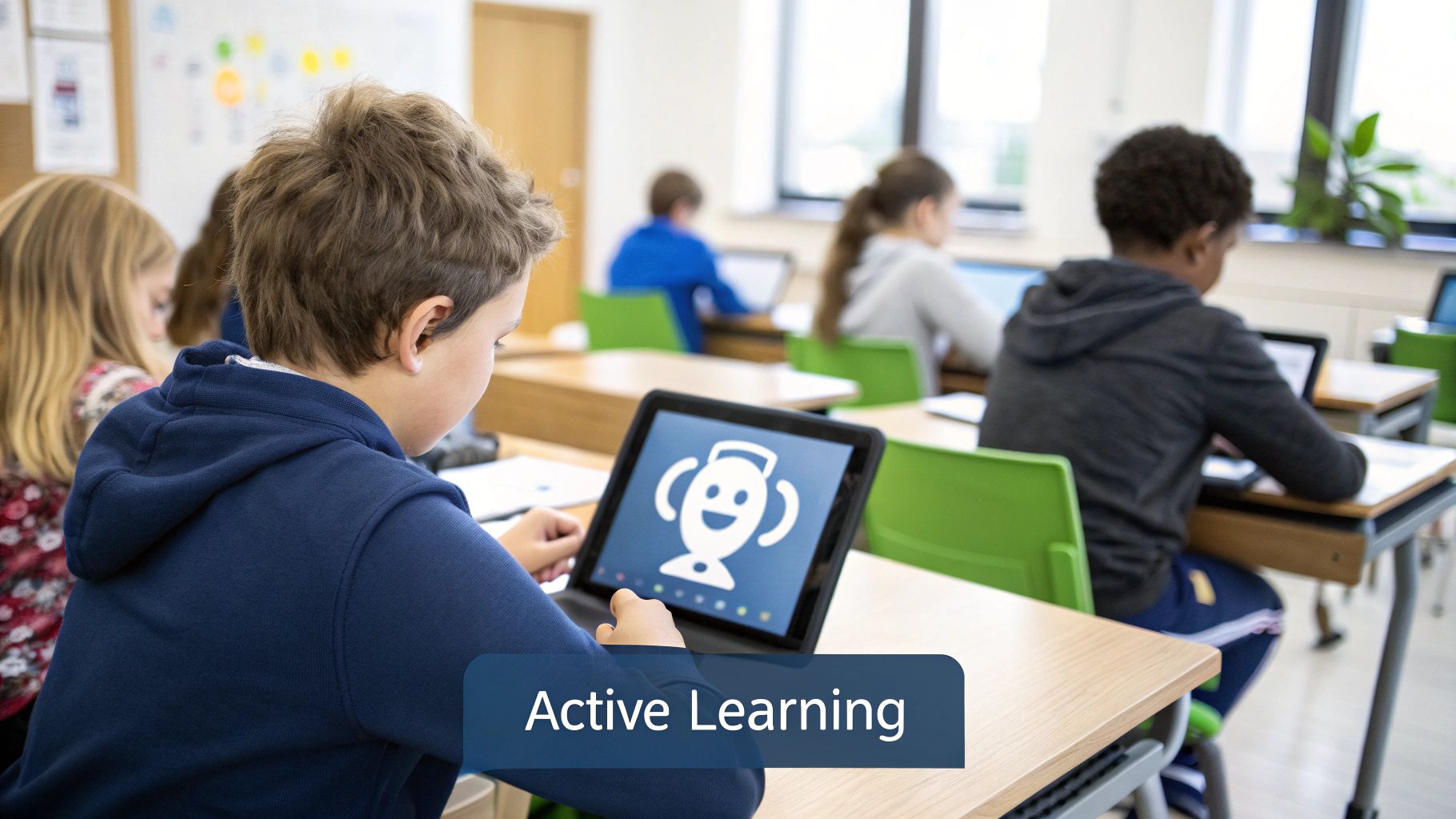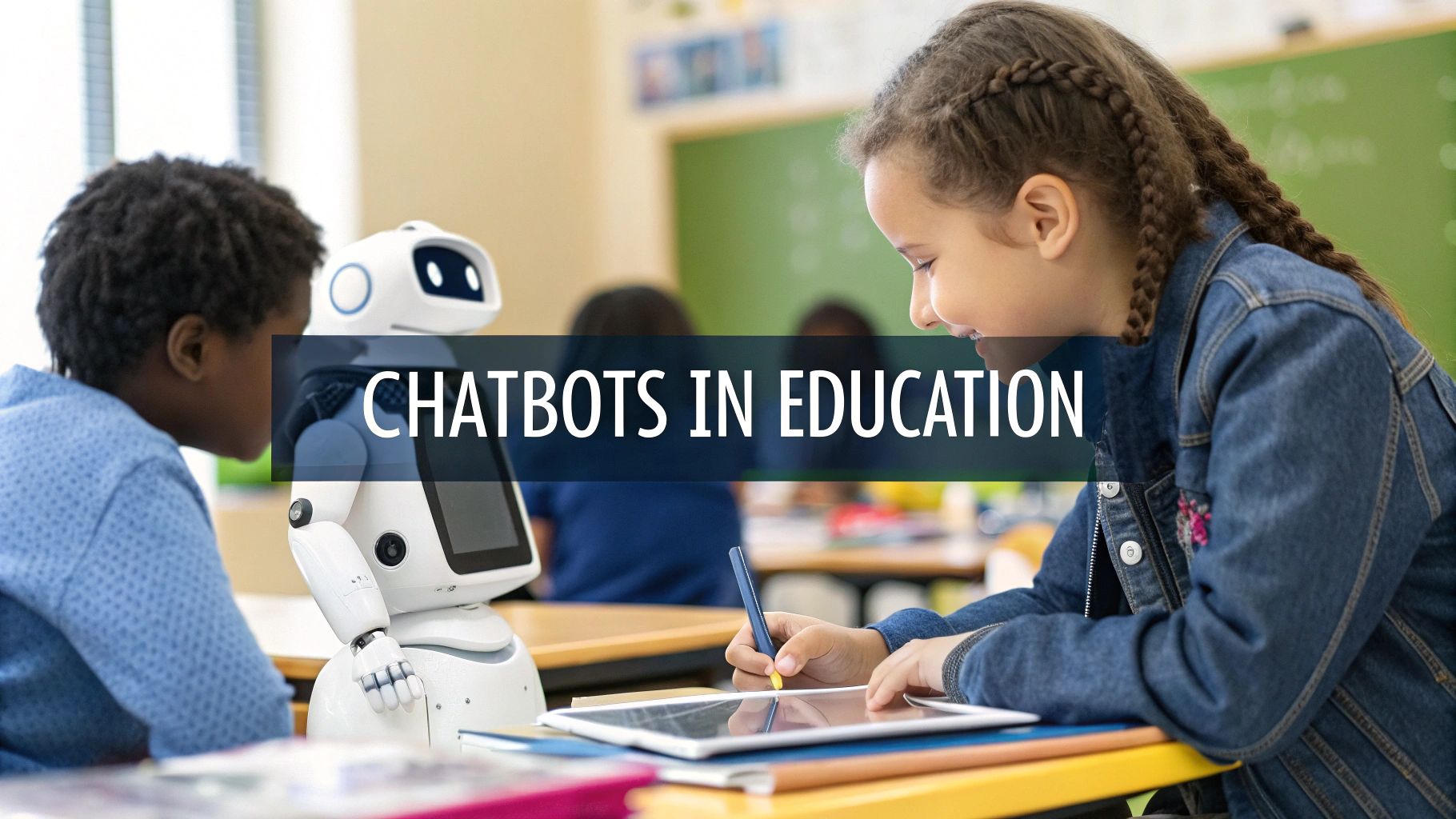Chatbots are showing up everywhere in education these days, and for good reason. Think of them as tireless, 24/7 study partners for students. They're built to provide instant answers, offer personalized learning support, and handle a lot of the routine administrative stuff.
The goal? To make education more accessible and efficient for everyone.
The Rise of the 24/7 AI Study Partner
Imagine a tutor who never sleeps. They're always patient and can break down a tricky concept for you at 2 AM, right when you're stuck on homework. This isn't science fiction anymore—it's what chatbots in education are making possible.
It's best to think of them not as replacements for teachers, but as dedicated, always-on assistants. They're there to empower both students and educators, acting as interactive learning companions that are available anytime, anywhere.
This constant availability is a total game-changer. Students no longer have to wait for office hours to get a question answered or feel lost over the weekend. Instead, they can jump into a chat with an AI assistant that provides immediate feedback, custom explanations, and guided practice.
Redefining Student Support
This move toward automated assistance is quickly changing how schools and universities operate. The rapid adoption is all thanks to some very clear benefits for both learners and the people running the show.
- Instantaneous Help: Chatbots can deliver real-time answers to all those frequently asked questions, from clarifying course content to helping someone find their way around campus.
- Personalized Pace: The AI is smart enough to adapt to an individual student's learning speed. It can offer extra resources or explain things in a different way if someone is struggling.
- Administrative Efficiency: Bots can easily handle routine inquiries about admissions, class schedules, and financial aid. This frees up human staff to focus on more complex student needs. For example, a prospective student can get immediate guidance from an AI course advisor like this one: https://www.chatbotgen.com/chat-with/course-advisor.
The concept map below gives you a bird's-eye view of the core functions these bots perform to support modern learning.

As you can see, a single piece of technology can deliver personalized learning, automate administrative tasks, and provide constant support—all at the same time. A great example is an interactive video summary chatbot, which can seriously boost learning by letting students quickly find specific information inside a long lecture video.
To give you a clearer picture of their main roles, here's a quick breakdown.
Core Functions of Educational Chatbots
This table summarizes the primary jobs chatbots take on in a learning environment, making it easy to see just how capable they are.
| Function | Description | Example |
|---|---|---|
| Academic Tutoring | Provides instant, one-on-one help with homework, explains complex topics, and offers practice exercises. | A student asks for help solving a calculus problem and gets a step-by-step guide. |
| Administrative Support | Answers common questions about admissions, enrollment, course schedules, and financial aid. | A new student asks, "When is the deadline to register for fall classes?" |
| Student Engagement | Sends reminders for assignments, shares campus news, and facilitates collaborative learning activities. | A bot sends a notification: "Don't forget, your history paper is due Friday!" |
These functions show how chatbots are becoming an indispensable part of the modern educational toolkit.
Why Schools Are Embracing AI Chatbots
It's no secret that schools and universities are jumping on the AI chatbot trend. But this isn't just about chasing the latest tech. It’s about solving very real, very persistent problems that have plagued education for years. The real motivation here is to make the entire educational experience better for everyone, from the students pulling all-nighters to the administrative staff buried in paperwork.

One of the biggest wins is achieving personalized learning at scale. Think about it: in a typical classroom, one teacher simply can't create 30 unique lesson plans tailored to each student's pace. Chatbots, on the other hand, can act as individual tutors. They adapt their approach on the fly based on how a student is doing, offering extra practice or tougher challenges right when they're needed.
This kind of flexibility means no one gets left in the dust or held back. If a student nails a concept, the bot can serve up the next topic. If they're struggling, it can break things down with simpler examples until the lightbulb goes on.
Enabling 24/7 Academic Support
Learning doesn't clock out at 3 PM. In fact, some of the most critical questions pop up late at night during a tough homework assignment or cram session. This is where chatbots truly shine by providing around-the-clock academic help.
Having that instant support is a game-changer. It cuts down on student frustration and stops small misunderstandings from snowballing into major learning gaps. By giving immediate answers and guidance, chatbots in education help create a learning environment that feels more supportive and a lot less stressful.
As AI tools become standard issue in education, students are leaning on them more and more to get through their workload. This constant access to help is completely changing what "study time" looks like outside of school hours.
By 2025, AI-powered chatbots have become an everyday tool in the education world. A whopping 92% of students globally say they regularly use AI tools for their studies. A huge reason for this shift is the simple desire to save time and turn in better work, a motivation shared by nearly half of all users. You can dig into more of this data in this detailed report on student AI usage from programs.com.
Streamlining Administrative Efficiency
Beyond the classroom, chatbots are a massive help on the administrative side. School offices are constantly bombarded with the same questions over and over: "When's the application deadline?" "How do I register for this class?" "Where do I find financial aid info?" An AI chatbot can field the vast majority of these queries instantly.
Automating this frees up staff to work on things that actually require a human touch. Things like:
- Giving in-depth advice to students facing serious challenges.
- Working on bigger-picture strategies for enrollment and student retention.
- Handling complex student issues that need real empathy and creative problem-solving.
By taking the routine questions off their plate, schools can run a much tighter ship, cut down on administrative costs, and pour more resources back into what really matters: student success.
How Chatbots Are Used in the Classroom
Let's move from theory to what this actually looks like in practice. How are chatbots in education really changing the day-to-day for students and teachers? Forget simple Q&A bots—these AI tools are becoming dynamic partners in learning across a ton of different subjects.
They're making education far more interactive and, frankly, more accessible for everyone involved.

Language learning is probably one of the most popular uses. Picture a student trying to get fluent in Spanish. Instead of just drilling flashcards, they can jump into a realistic, low-pressure conversation with a chatbot.
The bot patiently corrects their grammar, offers up new phrases, and can run through dialogues over and over. This helps build real confidence and fluency without the classic fear of making mistakes in front of the whole class.
That same idea works wonders in complex STEM fields, too. A physics student who's completely stuck on a problem can turn to an AI tutor. But the bot doesn't just hand over the answer. It gently guides them through the problem-solving steps with smart hints and clear explanations. This reinforces their critical thinking and makes sure they actually get the core concepts.
Fostering Deeper Research and Accessibility
Chatbots also shine as smart research assistants, totally changing how students find and use information. A student can ask a bot to pull up peer-reviewed articles on a niche topic, summarize the main points of a dense academic paper, or even help brainstorm a solid research question.
It cuts through the noise of endless search results, freeing up students to focus on the important stuff: analysis and writing.
On top of that, these tools are making education a more level playing field. Generative AI educational chatbots offer instant, personalized help 24/7, which is a huge deal for accessibility. They also have language translation features that can break down barriers for international students, helping them settle into a new academic environment. You can find more insights on how AI supports diverse student populations at naspa.org.
A chatbot can act as a personal librarian, a patient tutor, and a practice partner all in one. Its role is to fill the gaps, offering support exactly when and where a student needs it most, which is often outside the traditional classroom walls.
This kind of tailored support is why so many institutions are bringing this tech on board. If you're curious about how this could look at your own institution, check out our guide on the versatile chatbot for educational institutes.
Comparing Chatbot Use Cases Across Subjects
To give you a clearer picture of just how flexible these AI tools are, here's a quick look at how they can be adapted for different subjects. While the goal is always to deepen a student's understanding, the methods are tailored to what each specific field demands.
Chatbot Applications Across Different Subjects
This table shows how chatbots can provide specific, subject-oriented support in various academic areas.
| Subject Area | Chatbot Application | Learning Outcome |
|---|---|---|
| History | Simulates conversations with historical figures. | Deeper engagement with historical context and empathy. |
| Mathematics | Provides step-by-step guidance for solving equations. | Improved problem-solving skills and conceptual clarity. |
| Literature | Helps analyze literary themes and character development. | Enhanced critical analysis and essay-writing abilities. |
| Chemistry | Offers interactive lab simulations and safety quizzes. | Better retention of complex formulas and procedures. |
As you can see, each application is designed to shift learning from a passive activity to an active one. Students learn by doing, exploring, and interacting directly with the subject matter, which is the best way to build knowledge that actually sticks.
Implementing a Chatbot in Your Institution
Bringing a chatbot into your school or university can feel like a huge undertaking, but it doesn't have to be. If you break it down into a clear roadmap, the whole process becomes much more manageable. This isn't about flipping a switch and hoping for the best; it's a strategic move that, when done right, provides real value to both students and staff from the get-go.

The very first step is to get specific about your goals. Are you trying to cut down on the flood of emails overwhelming the admissions office? Or maybe you want to give students after-hours homework help for a notoriously tough course. Pinpointing a clear, measurable objective is the key to focusing your efforts and knowing what success looks like.
Charting Your Course to Implementation
With a goal in hand, your next big decision is whether to build a custom chatbot from scratch or go with a ready-made solution. Building it yourself offers total customization, but it also demands serious technical skill, time, and money. Buying, on the other hand, lets you get up and running much faster by using a platform that handles all the technical heavy lifting for you.
No-code platforms like ChatbotGen exist for this very reason—they let you create a powerful bot without writing a single line of code. If you want to dig into the details, you can learn more about how to build a chatbot with our complete guide. This approach frees up your team to focus on what they do best: the content and strategy, not the complex backend code.
No matter which path you take, your chatbot's intelligence will come from the data you give it.
A chatbot is only as smart as the information it's trained on. To be truly helpful, it needs to be fed high-quality, relevant data that accurately reflects your institution's knowledge base.
This means gathering everything from your course catalog and admissions FAQs to student handbooks and campus policies. The more comprehensive and accurate the data, the better your chatbot will be at answering student questions correctly and quickly.
From Pilot Program to Full Launch
Before you roll out a new chatbot to the entire student body, running a pilot program is absolutely essential. Think of it as a dress rehearsal. A small, controlled test group can give you priceless feedback on the bot's performance, how easy it is to use, and whether it's actually helpful.
Here’s a simple, three-step process for a successful launch:
- Define the Scope: Start small. Pick a single department, like financial aid or the IT help desk. This narrows the focus, making it much easier to train the bot and measure the results.
- Gather Feedback: Actively ask your pilot users for their thoughts. What questions stumped the bot? Was its tone right? Use this feedback to fine-tune its knowledge and conversational style.
- Iterate and Improve: A chatbot is never really "done." You have to keep updating it with new information and use its analytics to see what questions people are asking most often. This ongoing refinement makes sure the bot stays a valuable and trusted resource.
Finally, protecting student data is non-negotiable. Student information is sensitive, so whatever platform you choose must comply with all relevant data protection regulations. Be transparent with students about what data is being collected and why—it's the only way to build trust and get them to actually use the tool.
Navigating the Challenges of AI in Education
While the benefits are exciting, rolling out chatbots in education means we have to tackle some real challenges. These AI tools are incredibly powerful, but they aren’t foolproof. The first, and most important, hurdle is making sure they deliver accurate, unbiased information.
Remember, an AI chatbot is only as smart as the data it learns from. If that source material has built-in biases or is just plain wrong, the bot will spit those same errors back out. That’s why it’s critical for schools to hand-pick and constantly refresh the knowledge base their chatbots use, stopping misinformation in its tracks.
Beyond simple accuracy, there are some big ethical questions on the table. Student data privacy has to be a top concern. Schools need to be absolutely sure their chosen chatbot platform follows all data protection rules and is upfront about how student interaction data is handled.
Upholding Academic Integrity
Let's talk about the elephant in the room: academic integrity. The line between using a chatbot as a study buddy and letting it do your homework can get blurry, fast. This is where clear, institution-wide policies on acceptable AI use become non-negotiable.
As schools work on those policies, a huge part of the conversation for educators is understanding Turnitin's ability to detect ChatGPT and AI writing.
The goal shouldn't be to ban AI entirely. It's about teaching students to use it ethically—just like a calculator or a search engine. Building a culture of responsible AI use is far more effective than trying to police every single click.
Ultimately, it comes down to education for everyone. Clear rules let students know where the boundaries are, while proper training helps teachers design assignments that require critical thinking that an AI just can't fake.
Preventing Over-Reliance and Ensuring Equity
There's also the real risk of students becoming too dependent on AI. If a chatbot hands over the answer every time, it can get in the way of developing crucial problem-solving skills. The best chatbots in education don't just give answers; they guide. They should be prompting students with questions and nudging them toward a solution.
Finally, we have to talk about the digital divide. For chatbots to be a truly useful tool, every student needs fair access. That means thinking about learners who might not have a great internet connection or their own laptop.
Institutions can get ahead of this by making sure their chatbots are:
- Accessible on low-bandwidth connections so they run smoothly for everyone.
- Available in school computer labs and libraries for students who need them.
- Designed with simple interfaces that anyone can navigate without a user manual.
By thinking through these challenges from the start, schools can bring chatbots into the classroom in a way that’s safe, fair, and truly helpful for every learner.
The Future of Learning with AI Companions
The chatbots we see in education today are just the beginning. We're quickly moving past simple Q&A bots and into an era where AI acts less like a search engine and more like a genuine learning companion—one that can actually understand and respond to a student's emotional state.
Just imagine an AI mentor that notices when a student is getting frustrated with a tricky math problem. Instead of just spitting out the answer, it could offer a word of encouragement or suggest a completely different way to approach it. This shift toward emotionally intelligent AI is set to make learning feel much more supportive and human.
And this future isn't just stuck on a computer screen. These AI companions are about to jump into whole new, immersive worlds.
Learning in New Dimensions
We’re right on the edge of seeing chatbots merge with virtual and augmented reality, creating learning environments we could only dream of a few years ago. Think about what this could look like:
- Practicing a big presentation in a virtual auditorium filled with an AI-powered audience, getting feedback from an AI coach in real-time.
- Running a chemistry experiment in your classroom with an AR chatbot overlay guiding you through each step safely.
- Walking through ancient Rome in VR, with an AI character acting as your personal tour guide, answering any question you can think of.
The ultimate goal here is a seamless partnership between human teachers and their AI counterparts. In this model, teachers get to focus on what they do best—inspiring and mentoring students—while the AI handles the personalized practice and one-on-one support, creating a richer, more effective learning ecosystem for everyone.
Frequently Asked Questions About Educational Chatbots
We've covered the benefits, use cases, and even the hurdles of using chatbots in education. Now, let’s tackle some of the most common questions I hear from educators, students, and school administrators.
Will Chatbots Replace Human Teachers?
Not a chance. The goal of an educational chatbot is to augment, not replace, human teachers. Think of them as tireless teaching assistants, built to handle routine questions and provide personalized practice for every single student.
This frees up educators to do what they do best: mentor, inspire critical thinking, and create the kind of dynamic classroom experiences that technology just can't replicate. The teacher’s role evolves from just delivering information to facilitating much deeper learning.
Are Chatbots Safe for Students to Use?
Student safety and data privacy are completely non-negotiable. Any reputable educational chatbot platform is built from the ground up to comply with strict data protection regulations. When you're looking to implement a bot, your top priority must be finding a solution with rock-solid security protocols.
A few key features to look for include:
- Content Filters: To ensure every interaction stays appropriate and on-topic.
- Transparent Data Policies: You should know exactly what information is collected and how it's being used.
- Compliance with Regulations: Adherence to standards like FERPA and GDPR is an absolute must.
A secure learning environment is the foundation of trust. Without it, students and parents will hesitate to adopt new tools, no matter how effective they are.
How Can Our School Get Started?
My best advice? Start small by solving one specific, high-impact problem. Don't fall into the trap of trying to build a chatbot that does everything at once. Instead, pinpoint a single area where automation can provide immediate, noticeable value.
For example, you could run a pilot program with the admissions office to handle questions from prospective students. Or, you could set one up for a large introductory course to answer common homework queries. This lets you test the technology, gather feedback from real users, and prove its value before you think about scaling up across the entire institution.
Ready to build a smarter, more efficient learning environment? With ChatbotGen, you can create a no-code AI assistant for your school in minutes. Start your free trial today and provide instant support to your students and staff. Visit https://chatbotgen.com to learn more.
